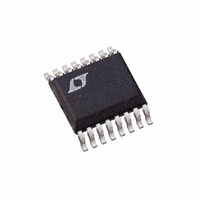LTC1867LACGN#TRPBF Linear Technology, LTC1867LACGN#TRPBF Datasheet - Page 13

LTC1867LACGN#TRPBF
Manufacturer Part Number
LTC1867LACGN#TRPBF
Description
IC ADC 16BIT 8CH 175KSPS 16SSOP
Manufacturer
Linear Technology
Datasheet
1.LTC1863LCGNPBF.pdf
(16 pages)
Specifications of LTC1867LACGN#TRPBF
Number Of Bits
16
Sampling Rate (per Second)
175k
Data Interface
MICROWIRE™, Serial, SPI™
Number Of Converters
1
Power Dissipation (max)
2.7mW
Voltage Supply Source
Single Supply
Operating Temperature
0°C ~ 70°C
Mounting Type
Surface Mount
Package / Case
16-SSOP (0.150", 3.90mm Width)
Lead Free Status / RoHS Status
Lead free / RoHS Compliant
Available stocks
Company
Part Number
Manufacturer
Quantity
Price
APPLICATIONS INFORMATION
If the CS/CONV returns low during a bit decision, it can
create a small error. For best performance ensure that the
CS/CONV returns low either within 100ns after the conver-
sion starts (i.e. before the fi rst bit decision) or after the
conversion ends. If CS/CONV is low when the conversion
ends, the MSB bit will appear on SDO at the end of the
conversion and the ADC will remain powered up.
Sleep Mode
If the SLP = 1 is selected in the input word, the ADC will
enter SLEEP mode and draw only leakage current (pro-
vided that all the digital inputs stay at GND or V
release from the SLEEP mode, the ADC needs 80ms to
wake up (charge the 2.2μF/10μF bypass capacitors on
V
Board Layout and Bypassing
To obtain the best performance, a printed circuit board
with a ground plane is required. Layout for the printed
circuit board should ensure digital and analog signal lines
are separated as much as possible. In particular, care
should be taken not to run any digital signal alongside
an analog signal.
All analog inputs should be screened by GND. V
COMP and V
as close to the pin as possible; the low impedance of the
common return for these bypass capacitors is essential
to the low noise operation of the ADC. The width for these
tracks should be as wide as possible.
(LTC1863)
(LTC1867)
CS/CONV
REF
SDO
SDO
SCK
SDI
/REFCOMP pins).
Figure 6. Example 1, CS/CONV Starts a Conversion and Remains HIGH Until Next Data Transfer. With CS/CONV
Remaining HIGH After the Conversion, Automatic Nap Modes Provides Power Reduction at Reduced Sample Rate
Hi-Z
Hi-Z
DD
t
CONV
should be bypassed to this ground plane
DON'T CARE
DON'T CARE
NAP MODE
MSB
MSB
D15 D14 D13
D11 D10
SD
1
DD
REF
0S
). After
2
, REF-
S1
D9
3
D12
S0
D8
4
COM UNI SLP
D11 D10
D7
5
Timing and Control
Conversion start is controlled by the CS/CONV digital in-
put. The rising edge transition of the CS/CONV will start a
conversion. Once initiated, it cannot be restarted until the
conversion is complete. Figures 6 and 7 show the timing
diagrams for two types of CS/CONV pulses.
Example 1 (Figure 6) shows the LTC1863L/LTC1867L
operating in automatic nap mode with CS/CONV signal
staying HIGH after the conversion. Automatic nap mode
provides power reduction at reduced sample rate.
The ADCs can also operate with the CS/CONV signal
returning LOW before the conversion ends. In this mode
(Example 2, Figure 7), the ADCs remain powered up. The
digital output, SDO, will go HIGH immediately after the
conversion is complete if the analog inputs are above
half scale in unipolar mode or below half scale in bipolar
mode. This is a way to measure the conversion time of
the A/D converter.
For best performance, it is recommended to keep SCK, SDI,
and SDO at a constant logic high or low during acquisition
and conversion, even though these signals may be ignored
by the serial interface (DON’T CARE). Communication
with other devices on the bus should not coincide with
the conversion period (t
Figures 8 and 9 are the transfer characteristics for the
bipolar and unipolar mode.
D6
6
D9
D5
7
D8
D4
8
D7
D3
9
D6
D2
LTC1863L/LTC1867L
10
D5
D1
11
D4
D0
12
CONV
NOT NEEDED FOR LTC1863
1/f
D3
13
DON'T CARE
SCK
).
t
D2
ACQ
14
D1
15
D0
16
DON'T CARE
13
1863l7lfc
1863L7L F06









